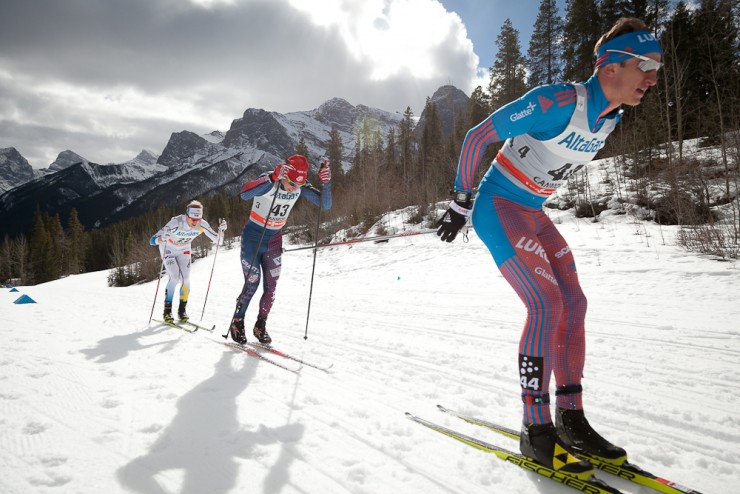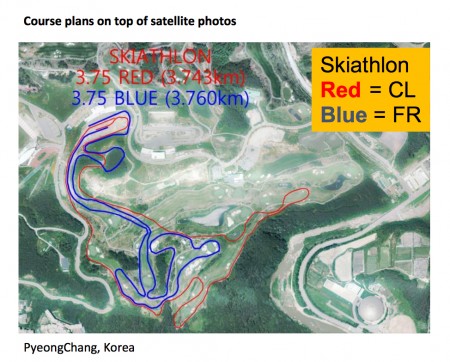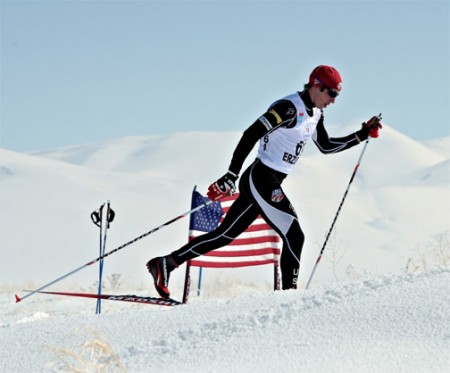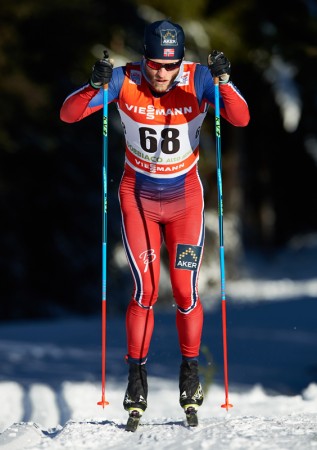
In so much as a social-media statement, the International Ski Federation (FIS), the governing body of cross-country skiing, proclaimed itself a curator. For some context, here is the definition of “curate” from an old-school source, Merriam-Webster: one who has the care and superintendence of something; especially : one in charge of a museum, zoo, or other place of exhibit.
Back to the FIS tweet from last Friday.

Assuming FIS’s words were chosen carefully, the words “defend classic technique” stand out. It makes the assumption that FIS perceives that classic technique was/is under attack — that it requires protection from those tainting its technical sanctity.
All the rumbling has to do with the decision to enforce a new rule limiting the maximum pole length to 83 percent of a skier’s total height (with boots on) during FIS-sanctioned classic cross country ski races.
This Wednesday, FIS Cross Country published a Q & A on its website. In response to why the rule was accepted, FIS reiterated that it believed desperate times warrant desperate measures. “The evolution of double poling has been challenging the core of the Cross-Country Skiing sport. Several measures to slow down this development have been put in place (see paragraph 5),” it stated.
Paragraph five in the document notes: “This will not stop anyone from double poling even in steep uphills but it is expected to stop the unwanted evolution of classic technique. The experiences from the upcoming season will be carefully examined next spring and further steps including a lowering of the percentage may be discussed.”
Field of play
Moving forward, let’s assume those percentages for pole length are a moving target. Rather than being relegated to museum status, classic technique remains living history.
In recent years, if the image you’re seeking is to watch World Cup skiers stride up hills exclusively, then perhaps you’re wanting.
On certain World Cup distance classic courses like Toblach (Italy) or Davos (Switzerland), and sprint courses like Drammen (Norway) and Stockholm (Sweden), it’s just as likely a double poler on skate skis prevails than a nordie with the magic combo of bomber kick and zippy skis. Some call it evolution, others, like FIS, call it an affront to a technique that has historically defined the sport and anchored it to the past.
It does beg the question, what is the responsibility of a sport’s international governing body when it may have promoted that evolution in the first place?
“In skiing, the field of play has changed tremendously and it has been driven by the governing body and that has driven the evolution of sport,” Zach Caldwell, of Caldwell Sport, said in a recent phone interview. “That’s why athletes are more powerful. Classic technique is totally different from what it was 30 years ago, 40 years ago. Completely different. Some of it is just plain equipment innovation, but mostly the equipment innovation reflects the field of play.”
What Caldwell is referring to when he mentions “field of play,” which he did several times during the interview, is the actual classic-ski course. The ups and downs, course width, tracks, and resulting new-school skiing speed. FIS homologation requirements are extensive and technical. According to the 2016 FIS Cross Country Homologation Manual, modern FIS-approved courses should be “⅓ uphill, ⅓ downhill, and ⅓ undulating terrain”. Those uphills are broken down into “A”, “B” and “C” climbs where percent of the course’s total climbing and a specific hill’s percent grade have strict parameters. To fully understand the homologation document, be prepared for some basic math.

FIS also opines on the subjective and murky territory of correlating course design, or field of play as Caldwell says, with human emotion when it states boldly in section 2.3 of the manual that, “The joy of skiing should be the ultimate goal”. (Note: FIS’s underline, not FasterSkier’s).
Joyful or not, Caldwell asserts that FIS has made an effort in its course requirements that have inadvertently promoted the use of double poling.
“Sport governing bodies need to understand that innovation is a product of the field of play that they have put in front of skiers,” Caldwell explained. “The FIS has made a series of decisions over the last decade to push the sport toward ever-faster speeds. The homologation requirements. The course width requirement. They apply a best line to the width of the course that they have got now and the speed, the average speed that they are producing on the average course permeation, demands double poling. It becomes compelling because of the sport that FIS has built. FIS has built this sport purposefully because they think they think it is going to be more compelling for a TV audience. They wanted a faster sport. They wanted a sport that looks better on televisions … it doesn’t look so much like old folks grinding it out. It looks like a flashy fast thing: that’s double poling … But to respond to innovation based on the field of play that they have put forth by deducing to add regulations about equipment or whatever else, it is kind of disingenuous and it’s a demand made by a bunch of people thinking really only about World Cup racing, not about the vast number of FIS races out there or about the practicalities of growing junior skiers or any of this. And frankly it’s not going to make a difference. People are going to double pole because that is the sport that FIS has built.”
Another nordic lifer, Fairbanks resident, former U.S. Ski Team coach (1990-1993) and passionate ski-course designer, is John Estle. In an email, Estle pointed out that Europe’s snow conditions have played a part in the emergence of double poling.
“Last winter many, if not most World Cup competitions were conducted on exclusively or primarily man-made snow,” Estle wrote. “The sometimes icy (and often rock-hard) quality of that snow, as well as races held in sketchy waxing conditions also promote double-poling. Not to mention the influence of the use of double-poling by winners of all the major classic marathons.”
At the core of evolution is the premise that evolutionary change is prompted by changes in environmental conditions — crudely put, it’s survival of the fittest. Estle agrees with Caldwell in that the modern field of play has incentivized double poling. “To this point, double-poling by many or most skiers in an event is correlated most closely with terrain … That may change in the future as skiers become stronger but for now the closest correlation is indisputably between ‘flat’ courses and double-poling,” Estle commented.
Like courses, all skiers are not equal. For some double poling may be a practical answer to modern course design, for some it is not. Caldwell asserts that on the World Cup and the vast series of FIS races like its Marathon Cup, double poling will have its day, but it most likely will remain an option for a few.
“If they [FIS] left it alone, if they let the top guys double pole, you would have the entire rest of the population of the skiing world try it, fail and continue to wax their skis,” Caldwell said of FIS’s broad-stroke solution to what he sees as a non-issue. “The level that is required to double pole is really, really high … The vast majority of skiers are not going to be well served by double poling entire marathons or distance cross-country races.”
The trend of more double poling, according to Caldwell, may eventually wane as skiers bump up against their maximum power output. “It’s going to balloon, it’s going to bubble and it’s going to burst because there are physiological reasons to use your legs more, to use your legs more actively in less of a static mode,” Caldwell said. “You know, just as soon as everyone figures out they can double pole races really fast, some kid’s going to show up and start striding them and beat everyone.”
“It’s going to balloon, it’s going to bubble and it’s going to burst. … Just as soon as everyone figures out they can double pole races really fast, some kid’s going to show up and start striding them and beat everyone.” — Zach Caldwell on the double-pole trend
Estle asserted that how sport is played by elite athletes does not categorically promote seismic change at lower levels. “I don’t dunk, but I like to watch NBA and college basketball and occasionally to shoot hoops; I don’t throw a baseball 100 mph, but I like to play catch now and then, and still like to watch major league baseball. Sport at the highest level IN NO WAY resembles sport as practiced by the vast majority of practitioners. Where the elite level of sport competition has long since been out of the reach of the other 99% of participants, sports remain very popular to both spectators and participants. The fact that I can’t dunk doesn’t make me not want to watch the Golden State Warriors, nor does my lame arm prevent me from enjoying an MLB pitching duel between two flamethrowers.”
And as far as keeping the sport viable and exciting, Estle offers this: “If classic skiing at the highest levels evolves naturally into double-poling, that may not be a problem. On hilly courses, skiers will have to make an important strategic decision about whether to wax or not to wax. That makes the sport interesting.”
Ski Boots and Poles on the Ground: Hoffman’s Thoughts
Current U.S. Ski Team member Noah Hoffman, who is coached by Zach Caldwell, has the pole rule on his radar. For now, Hoffman hasn’t done the math, but he believes his poles will have to be cut by a centimeter or two. Amongst his U.S. teammates, he says he may be the only one unable to continue using his current length classic poles.
Of the skiers double poling classic courses on the World Cup with skate skis, Hoffman is not one of them.

“Double poling is a weakness and I have worked on it a lot of course,” Hoffman said on the phone. “But I don’t think it will ever be world-class and competitive internationally as a stand-alone technique.”
Hoffman knows his strong points and his limitations. “From an athletic standpoint, this rule change absolutely is a benefit to me because any rule that limits the amount of double poling is helpful to me in my career. … I respect the FIS council and the politics that go into it, but I don’t have a super-strong opinion.”
Running through this year’s World Cup venues, Hoffman explained he thought FIS had remedied the double-pole conundrum in the short term.
“Ulricehamn, the new venue in Sweden, is apparently quite flat. I have never skied there and that was pegged as a 15-kilometer classic race and that was the only other significant decision that came out of the FIS meetings last week: they switched that to a skate race and swapped it with Falun which will now be a classic race. So they have taken away the one venue where I think it was an issue,” he noted. “That being said, there were guys talking about double poling in Falun last year, which has the Mördarbacken. At least the loop they ran us on last year closes with three or four kilometers with gradual downhill terrain. It is a huge advantage not to have kick wax on your skis, and so I see the logic there. I don’t think that I can double pole a course like Falun faster than I can classic ski it, but I wouldn’t be surprised if some athlete can.”
Davos and Toblach are on the schedule, both slated as freestyle events. There’s Kuusamo (Finland), Lillehammer (Norway), Val di Fiemme (Italy), and Val Müstair (Switzerland) all hosting classic races. And skiathlons in La Clusaz (France) and Oberstdorf (Germany) — all scheduled before World Championships in Lahti.
“So you run through the venues and it’s all not an issue for me,” Hoffman said. “I don’t see any venue where it’s even close for me. But, I won’t be surprised if we see athletes double pole more hilly courses this year, but I won’t be one of them.”
Estle thought pole-length restrictions might impact those choosing kick wax as their best fastest option on the World Cup — athletes like Hoffman.
“Restricting the length of poles creates additional problems,” Estle wrote. “First, there may be (likely are) some skiers who like to classic ski, with wax on their skis, with poles that are longer than 83% of body height. Keeping them from using the poles they want in classic technique events doesn’t really accomplish anything. It will only make maximizing performance more difficult for those skiers.”
“There may be (likely are) some skiers who like to classic ski, with wax on their skis, with poles that are longer than 83% of body height…” — John Estle, former U.S. Ski Team coach (1990-1993)
Classic gasping on its death bed? Possible solutions
Caldwell believes classic technique is safe and double poling part of its natural evolution. Although he mentioned several solutions to incentivize striding on the field of play.
“The single biggest change that FIS could make to preserve striding is to create the need to accelerate from low speed to high speed on climbs; that’s really damn hard to do,” Caldwell advised if FIS wanted to ensure the preservation of kick and glide. The simple physics of gravity, steepness, inertia, and friction are restrictive.
“You start from a stop on an uphill and you have to accelerate that is not an easy task,” Caldwell said of how to modify courses to promote kick and glide. “If they were to put a series of hairpin corners on the uphills … what if they were to go to the groomers and say, ‘Hey look, give us a nice track pan, but then let’s just till up the snow and not compact it on either side for you know forty centimeters wide outside the track and create a mess of a poling platform so there is no good poling platform.’ There are tons of ways that they can prepare the courses, lay out the courses, and set them up to be disadvantageous for double poling.”

Estle’s solutions? “For now, my recommendation would be: 1) DO NOT implement no double-pole zones under any circumstances, 2) have classic races on courses with big/long/steep uphills, 3) apply the pole-length rules only at the highest level of competition and 4) make enforcement the responsibility of the Jury. The sport is already complicated enough!”
In its Q & A, FIS made some clarifications in terms of enforcement. Athletes will be able to check the legality of their poles during training. “The controls will be performed randomly and/or will be targeted,” it stated. “It will be possible to perform the measurements before the start and after the finish. If necessary, more than one measurement device will be available.”
Break a single pole during the race, FIS has you covered. Snap a single pole and receive a replacement greater than the 83-percent rule, you’re still in compliance. Break two poles, then it’s a strict application — “the poles must comply with the 83% body length rule.”
Former U.S. Ski Team member and Alaska resident Tim Kelley had this observation: “The fate of classic skiing is up to the younger generations. There was a couple of years in the mid 80’s classic pretty much disappeared as all races were ‘freestyle’, your choice of technique. So it was skating in classic boots and with short poles for a bit. But it seems classic skiing has resiliency. It survived a short death in the 80’s and was revived. Should be interesting to see how classic skiing bodes in the future.”
Jason Albert
Jason lives in Bend, Ore., and can often be seen chasing his two boys around town. He’s a self-proclaimed audio geek. That all started back in the early 1990s when he convinced a naive public radio editor he should report a story from Alaska’s, Ruth Gorge. Now, Jason’s common companion is his field-recording gear.



